Fiber-reinforced geopolymer composite (FRGC) is emerging as one of the alternative materials for cement in the construction industry. FRGC is considered an eco-friendly material due to its role in the global reduction in emission of CO2 to the environment. Simultaneously, the composite provides good mechanical strength of flexural modulus, loss modulus, post-impact strength, and durability for a definite period at room and elevated temperatures. A positive aspect of the geopolymer matrix used for this composite is that could provide a finite period of durability at elevated temperatures without releasing toxic gases to the surroundings. Fibers enhanced the brittle behavior of the geopolymer matrix into ductile one with improved mechanical strength and residual impact strength.
- fiber
- geopolymer
- fiber-reinforced geopolymer composite (FRGC)
1. The Physical, Chemical, and Mechanical Domains of Geopolymer-Based Composite
1.1. Chemical Structure of Geopolymer Matrix
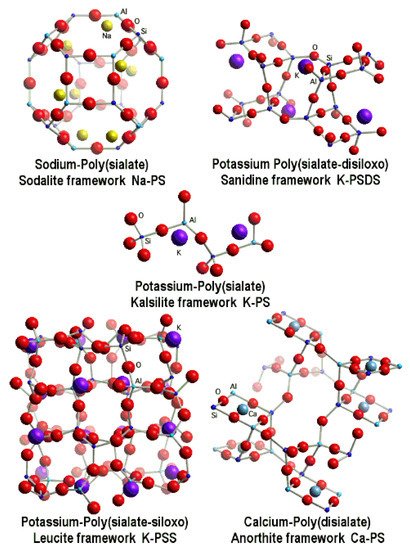
Figure 1.
https://www.geopolymer.org/science/examples-geopolymer-frameworks/
1.2. The Domain of Composites in Various Fields

Figure 2.
http://www-materials.eng.cam.ac.uk/mpsite/interactive_charts/default.html
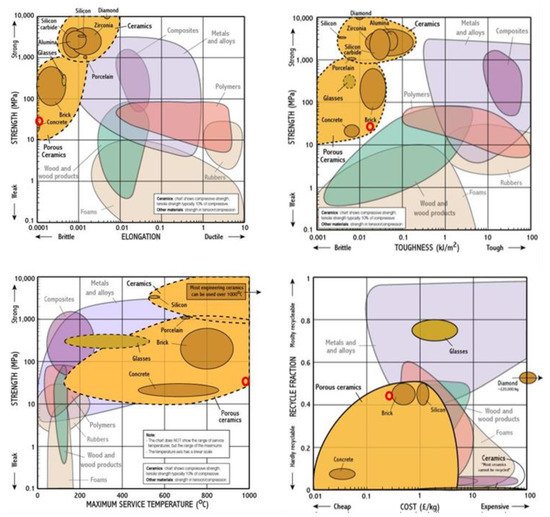
Figure 3.
http://www-materials.eng.cam.ac.uk/mpsite/interactive_charts/default.html
2
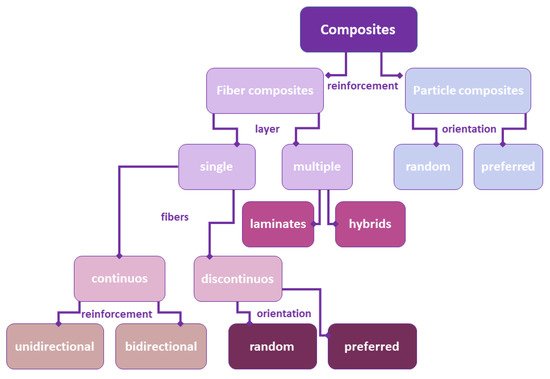
Figure 4.
2. Characterization of Pure Geopolymer and Fiber-Reinforced Composite
2.1. Characterization of Pure Geopolymer
[1]
3
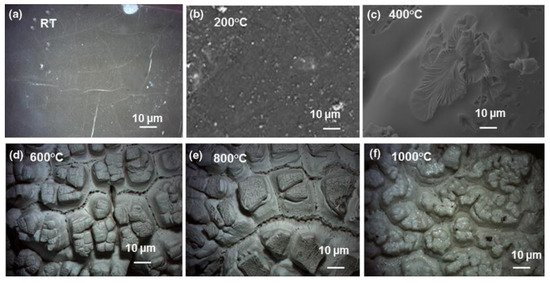
Figure 5.
a
b
f
[4]
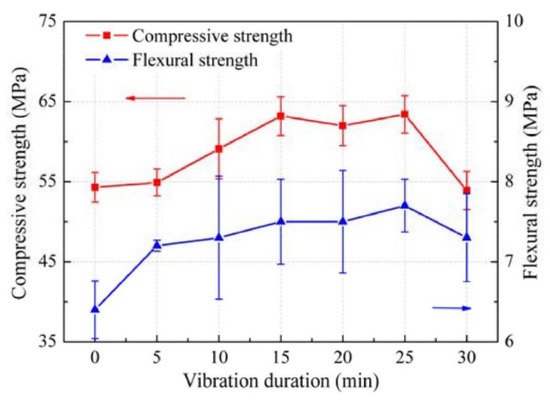
Figure 6.
[7]
2.2. Fiber-Reinforced Geopolymer Characterization
2.2.1. Synthetic Fibers Such as Carbon, E-glass, and Basalt Fiber-Reinforced Geopolymer Composites
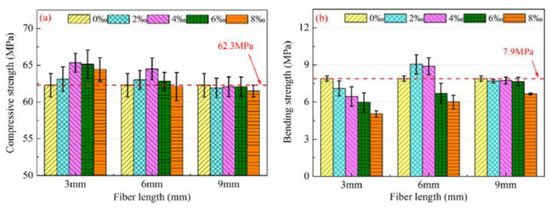
Figure 7.
a
b
[7]
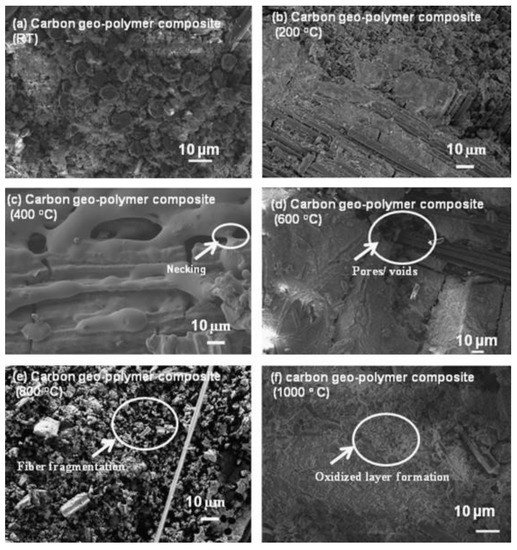
Figure 8.
a
b
f
[10]
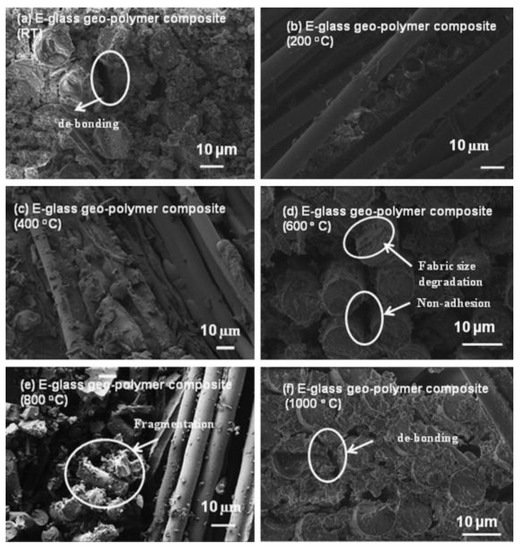
Figure 9.
a
b
f
[10]

Figure 10.
a
b
f
[10]
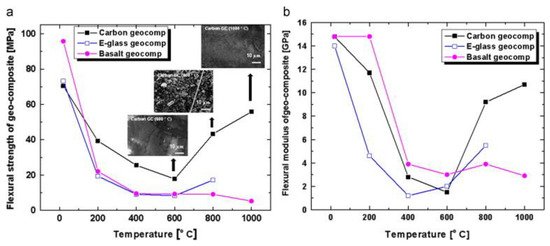
Figure 11.
a
b
[10]
2.2.2. Durability on Impact of Fiber-Reinforced Composite
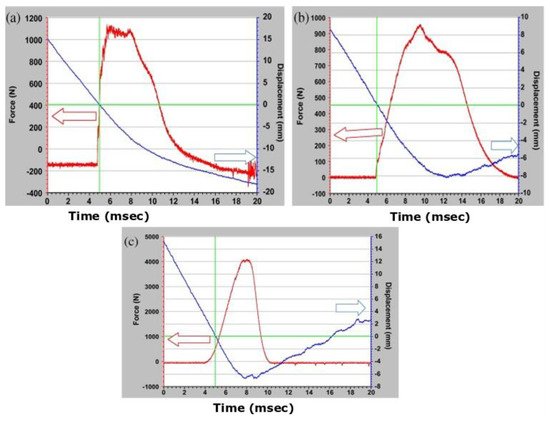
Figure 12.
a
b
c
[13]
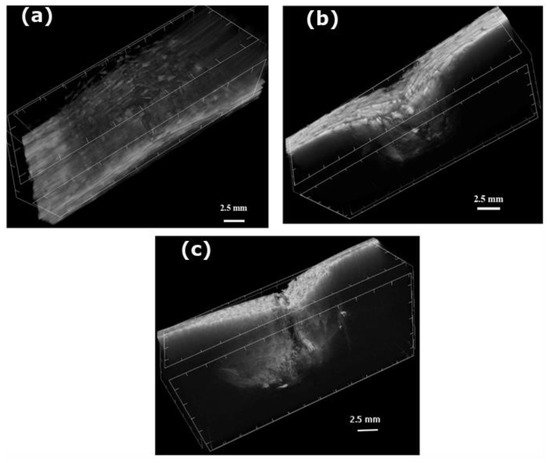
Figure 13.
a
b
c
[16]
2.2.3. Natural Fibers Such as Cotton, Flax, Jute Fiber Reinforced Geopolymer Composites

Figure 14.
a
b
[17]
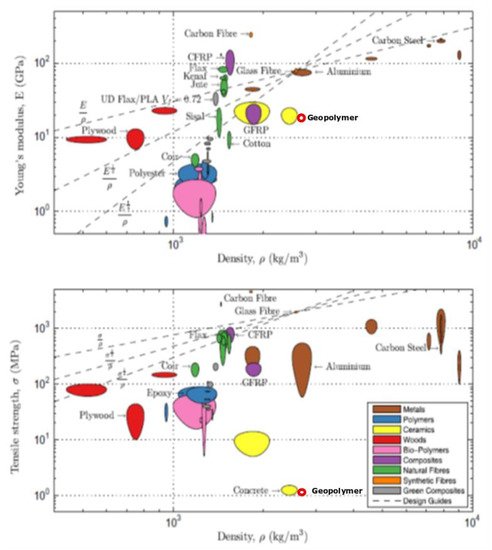
Figure 15.
[21]
Table 1.
[22][10][23][4][13][17][24][25][26][27]
| Geopolymer | Bulk Density (g/cm3) | Flexural Strength (MPa) | Flexural Modulus (GPa) | Compression |
|---|
| Matrix | 2.0± 0.1 | 27.8 ± 0.1 | 18.5 ± 0.1 | 11.7± 0.1 |
| Fibers | Bulk density (g/cm3) |
Tensile strength (MPa) | Elastic Modulus (GPa) | Ultimate Elongation (%) |
| Steel | 7.65–7.85 | 345–2850 | 200–210 | 0.5–3.5 |
| Carbon fiber, carbon nanotube | 1.4–2.2 | 500–3500 | 35–1800 | 0.3–2.5 |
| Synthetic Polymers | ||||
| PVA | 1.2–1.3 | 800–2500 | 29–42 | 5.7–7 |
| PP | 0.9–0.95 | 240–760 | 1.5–10 | 15–80 |
| PE | 0.92–0.97 | 80–3500 | 5–113 | 3–100 |
| Aramid | 1.38–1.47 | 2300–3500 | 63–120 | 2–4.5 |
| Acrylic | 1.16–1.18 | 270–1000 | 13.8–19.3 | - |
| Polyester | 1.22–1.38 | 580–1100 | 15 | 35 |
| Nylon | 1.13–1.41 | 440–1000 | 4.1–5.2 | 16–20 |
| PET | 1.3–1.4 | 420–450 | 3.1–10 | 11.2 |
| Natural Fiber | ||||
| Jute | 1.3–1.5 | 250–350 | 26–32 | 1.5–1.9 |
| Sisal | 1.34–1.45 | 280–750 | 13–26 | 3.0–5.0 |
| Coconut | 0.87–1.4 | 120–200 | 19–26 | 10.0–25.0 |
| Bamboo | 0.6–1.1 | 140–800 | 11–32 | 2.5–3.7 |
| Cotton | 1.5–1.6 | 390–600 | 5.8–11 | 6.0–10.0 |
| Palm | 1.3–1.46 | 21–60 | 0.6 | - |
| Wool | 1.3 | 160 | 3.5 | - |
| Hemp | 1.4–1.5 | 270–900 | 23.5–90 | 1–3.5 |
| Kenaf | 1.4 | 223–930 | 14.5–53 | 1.5–2.7 |
| Coir | 1.15–1.46 | 95–230 | 2.8–6 | 15–51.4 |
| Banana | 1.4 | 500 | 12.0 | 1.5–9 |
| Flax fabric | 1.5 | 500–1500 | 50–70 | 1.1 |
| Bagasse | 1.3 | 222–290 | 17–27 | - |
| Inorganic fibers | ||||
| E-Glass | 2.5–2.62 | 3100–3800 | 72.4 | 4.8 |
| S-Glass | 2.46–2.49 | 4020–4650 | 86.9 | 5.4 |
| C-glass | 2.6 | 3310 | 69 | 4.8 |
| AR-glass | 2.7 | 3240 | 73 | 4.4 |
| Basalt | 2.65–2.80 | 3000–4840 | 89–110 | 3.00–3.15 |
| Asbestos | 2.55 | 620 | 160 | - |
| Alumina | 3.3–3.95 | 1700–2000 | 300–380 | 0.4 |
| Alumina-silica | 3.4 | 1590–2550 | 200–248 | 0.8–1 |
| SiN | - | 2500–4800 | 195–300 | - |
| SiC | 2.5–2.7 | 2200–3450 | 221–250 | - |
| BN | 7.65–7.85 | 2100 | 345 | - |
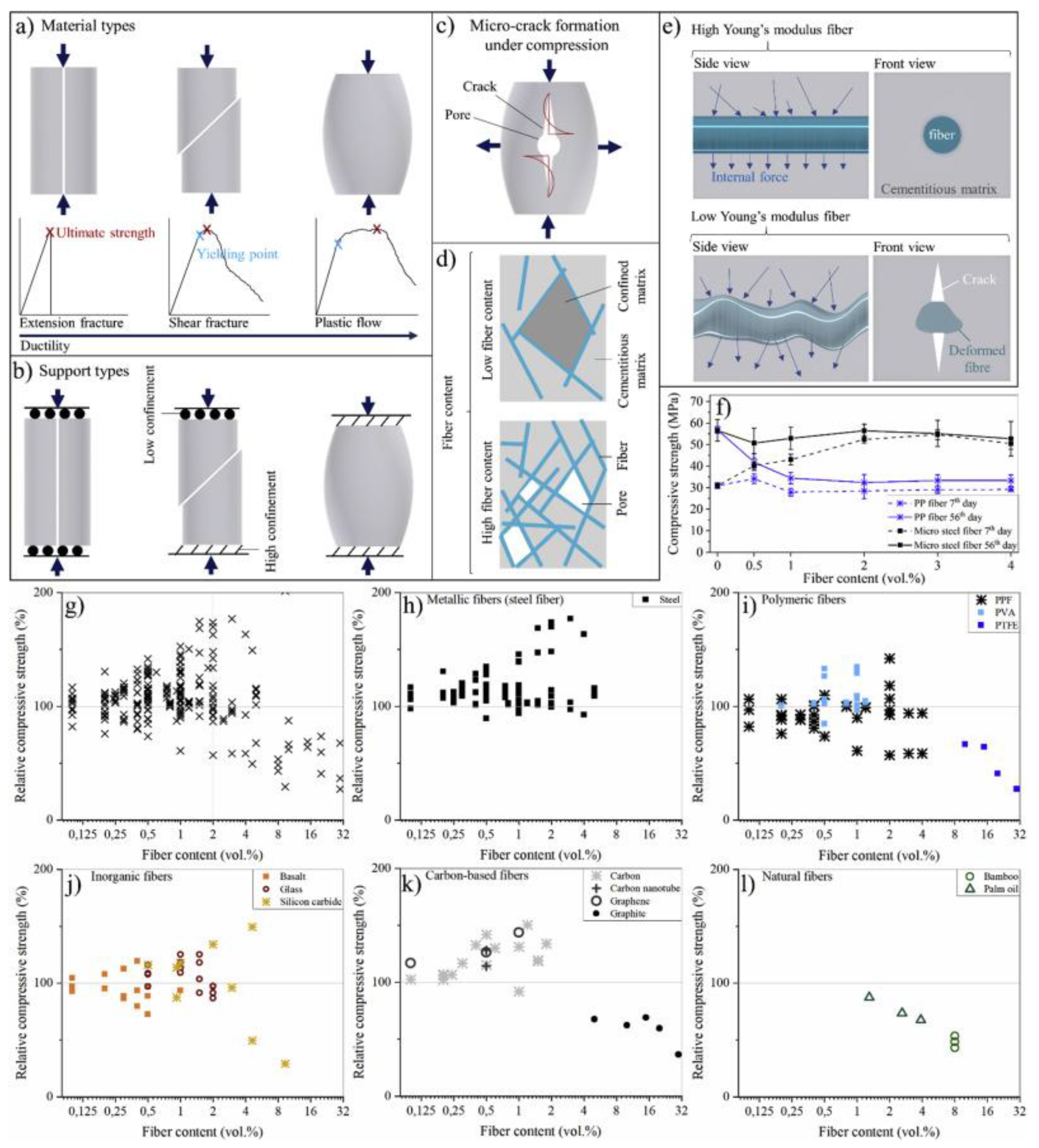
Figure 16.
a
b
c
d
e
f
g
h
i
j
k
l
[25]
References
- Samal, S.; Vlach, J.; Kolinova, M.; Kavan, P. Micro-computed tomography characterization of isotropic filler distribution in magnetorheological elastomeric composites. In Advanced Processing and Manufacturing Technologies for Nanostructured and Multifunctional Materials; Ohji, T., Singh, M., Halbig, M., Moon, K., Eds.; The American Ceramic Society: Westerville, OH, USA; Wiley: Hoboken, NJ, USA, 2016; pp. 57–69.
- Rashad, A.M. Effect of steel fibers on geopolymer properties—The best synopsis for civil engineer. Constr. Build. Mat. 2020, 246, 118534.
- Bazan, P.; Kozub, B.; Łach, M.; Korniejenko, K. Evaluation of Hybrid Melamine and Steel Fiber Reinforced Geopolymers Composites. Materials 2020, 13, 5548.
- Samal, S.; Thanh, N.P.; Marvalová, B.; Petríková, I. Thermal Characterization of Metakaolin-Based Geopolymer. JOM 2017, 69, 2480–2484.
- Samal, S.; Vlach, J.; Kavan, P. Improved mechanical properties of magneto rheological elastomeric composite with isotropic iron filler distribution. Ciênc. Tecnol. Mater. 2016, 28, 155–161.
- Kriven, W.M. Geopolymer based composites. Compr. Compos. Mater. II 2018, 5, 269–280.
- Bai, T.; Liu, B.; Wu, Y.; Huang, W.; Xia, Z. Mechanical properties of metakaolin-based geopolymer with glass fiber reinforcement and vibration preparation. J. Non Cryst. Solids 2020, 544, 120173.
- Hung, T.D.; Louda, P.; Kroisova, D.; Bortnovsky, O.; Xiem, N.T. New generation of geopolymer composite for fire-resistance. In Advances in Composite Materials—Analysis of Natural and Man-Made Materials; Tesinova, P., Ed.; InTech: London, UK, 2011; pp. 73–94.
- Mills-Brown, J.; Potter, K.; Foster, S.; Batho, T. The development of a high temperature tensile testing rig for composite laminates. Compos. A 2013, 52, 99–105.
- Samal, S.; Thanh, N.P.; Petríková, I.; Marvalová, B.; Vallons, K.A.M.; Lomov, S.V. Correlation of microstructure and mechanical properties of various fabric reinforced geo-polymer composites after exposure to elevated temperature. Ceram. Int. 2015, 41, 12115–12129.
- Alzeer, M.; MacKenzie, K.J.D. Synthesis and mechanical properties of new fiber-reinforced composites of inorganic polymers with natural wool fibers. J. Mater. Sci. 2012, 47, 6958–6965.
- Giancaspro, J.W.; Balaguru, P.N.; Lyon, R.E. Fire protection of flammable materials utilizing geopolymer. SAMPE J. 2004, 40, 42–49.
- Samal, S.; Marvalová, B.; Petríková, I.; Vallons, K.A.M.; Lomov, S.V.; Rahier, H. Impact and post-impact behavior of fabric reinforced geopolymer composite. Constr. Build. Mater. 2016, 127, 111–124.
- Ribero, D.; Kriven, W.M. Properties of Geopolymer Composites Reinforced with Basalt Chopped Strand Mat or Woven Fabric. J. Am. Ceram. Soc. 2016, 99, 1192–1199.
- Tran, D.H.; Kroisová, D.; Louda, P.; Bortnovsky, O.; Bezucha, P. Effect of curing temperature on flexural properties of silica-based geopolymer-carbon reinforced composite. J. Achiev. Mater. Manuf. Eng. 2009, 37, 492–497. Available online: (accessed on 1 April 2021).
- Samal, S.; Stuchlík, M.; Petrikova, I. Thermal behavior of flax and jute reinforced in matrix acrylic composite. J. Therm. Anal. Calorim. 2018, 131, 1035–1040.
- Alomayri, T.; Shaikh, F.U.A.; Low, I.M. Effect of fabric orientation on mechanical properties of cotton fabric reinforced geopolymer composites. Mater. Des. 2014, 57, 360–365.
- Study of Interfacial Adhesion between Nickel-Titanium Shape Memory Alloy and a Polymer Matrix by Laser Surface Pattern. Appl. Sci. 2020, 10, 2172
- Zhang, Y.; Sun, W.; Li, Z.; Zhou, X.; Chau, C. Impact properties of geopolymer based extrudates incorporated with fly ash and PVA short fiber. Constr. Build. Mater. 2008, 22, 370–383.
- Zhao, W.; Wang, Y.; Wang, X.; Wu, D. Fabrication, mechanical performance and tribological behaviors of polyacetal-fiber-reinforced metakaolin-based geopolymeric composites. Ceram. Int. 2016, 42, 6329–6341.
- Dicker, M.P.M.; Duckworth, P.F.; Baker, A.B.; Francois, G.; Hazzard, M.K.; Weaver, P.M. Green composites: A review of material attributes and complementary applications. Compos. Part A 2014, 56, 280–289.
- Samal, S. Effect of High temperature on the microstructural evolution of fiber-reinforced geopolymer composite. Heliyon 2019, 5, e01779.
- Samal, S.; Thanh, N.P.; Petríková, I.; Marvalová, B. Improved mechanical properties of various fabric-reinforced geocomposite at elevated temperature. JOM 2015, 67, 1478–1485.
- Silva, G.; Kim, S.; Aguilar, R.; Nakamatsu, J. Natural fibers as reinforcement additives for geopolymers—A review of potential eco-friendly applications to the construction industry. Sustain. Mater. Technol. 2020, 23, e00132.
- Ranjbar, N.; Zhang, M. Fiber-Reinforced geopolymer composites: A review. Cem. Concr. Compos. 2020, 107, 103498.
- Ganesan, N.; Abraham, R.; Deepa Raj, S. Durability characteristics of steel fibre reinforced geopolymer concrete. Constr. Build. Mater. 2015, 93, 471–476.
- Samal, S.; Škodová, M.; Abate, L.; Blanco, I. Magneto-Rheological Elastomer Composites. A Review. Appl. Sci. 2020, 10, 4899. https://doi.org/10.3390/app10144899
- Okada, K.; Imase, A.; Isobe, T.; Nakajima, A. Capillary rise properties of porous geopolymers prepared by an extrusion method using polylactic acid (PLA) fibers as the pore formers. J. Eur. Ceram. Soc. 2011, 31, 461–467.
- Ranjbar, N.; Talebian, S.; Mehrali, M.; Kuenzel, C.; Metselaar, H.S.C.; Jumaat, M.Z. Mechanisms of interfacial bond in steel and polypropylene fiber reinforced geopolymer composites. Compos. Sci. Technol. 2016, 122, 73–81.
- Sanjay, M.R.; Arpitha, G.R.; Yogesha, B. Study on Mechanical Properties of Natural—Glass Fibre Reinforced Polymer Hybrid Composites: A Review. Mater. Today Proc. 2015, 2, 2959–2967.
